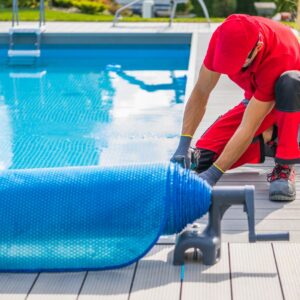
A sparkling pool doesn’t just happen—it takes a little regular care. Whether you’re spending weekends splashing around or preparing for the colder months, sticking to a routine is key. Weekly pool maintenance may sound like a chore, but with a solid plan, it’s quick, easy, and keeps your pool in great condition. Let’s dive into a simple checklist to make your life easier, with some seasonal tips to get you through the year, including swimming pool winter maintenance.
The Weekly Pool Maintenance Checklist
Even with automatic systems in place, pools need a bit of weekly TLC. Taking just 15-30 minutes a week can help you avoid bigger headaches like algae, murky water, or malfunctioning equipment. Here’s how to get started with the basics.
1. Skimming & Scrubbing
Skimming the surface of your pool to remove leaves, bugs, and other debris should be a quick, regular task. While daily skimming is best, setting aside time once a week works for most pools. A good, sturdy skimmer net is all you need.
Scrubbing the pool walls is just as important. Algae love to hang out in the shady spots, like pool steps, behind ladders, or corners. Using a pool brush, give those areas a good scrub each week to prevent buildup.
2. Clean the Filter
A clean filter is essential to keep your water circulating properly. Depending on your filter type, you’ll either need to hose down the cartridge, backwash a sand or DE filter, or clean out the skimmer baskets. Doing this once a week prevents clogs and helps keep your pool running smoothly.
- Cartridge filters: Remove the cartridge and rinse it off with a hose.
- Sand & DE filters: Backwash as needed to flush out trapped debris.
When the filter runs clean, your pool stays clear.
3. Water Level Check
The right water level helps your pool function properly. Too low, and your pump could run dry. Too high, and it messes with your skimmer’s ability to capture debris. Check your pool’s water level weekly to make sure it’s where it should be—ideally halfway up the skimmer opening. If it’s too low, use a garden hose to top it off, and if it’s too high after a rainstorm, use a submersible pump to drain the excess.
4. Test and Balance the Water Chemistry
Keeping your water chemistry balanced is the most important part of maintaining a healthy pool. Test your water at least once a week using a pool test kit or strips to measure:
- Chlorine: Keeps bacteria and algae in check. Aim for 1.0–3.0 ppm.
- pH: A balanced pH level (7.4–7.6) prevents skin irritation and equipment damage.
- Alkalinity: Keeps pH stable and should be between 80–120 ppm.
- Calcium Hardness: Prevents scaling and etching; keep it between 200–400 ppm.
If any levels are off, adjust with the appropriate pool chemicals. Adding chemicals correctly is key—follow the instructions carefully and give your pool time to circulate after treatment.
5. Vacuum the Pool
Just like sweeping your floors at home, vacuuming your pool keeps it looking clean. Whether you use an automatic pool cleaner or go old-school with a manual vacuum, this weekly step helps remove dirt, sand, and debris from the bottom. Pay special attention to areas where dirt tends to gather, like corners or along the pool walls.
Seasonal Maintenance: Adjusting Your Routine for the Weather
Weekly pool maintenance stays largely the same throughout the year, but it’s important to make small tweaks depending on the season. Here’s how to adjust your checklist based on the time of year, including tips for swimming pool winter maintenance.
Summer Pool Maintenance
In the summer, with more swimming and hotter temperatures, your pool will need extra attention to keep it safe and clean. This means stepping up your testing routine and being prepared for heavy water use.
- Test more often: Check water chemistry 2-3 times a week to stay ahead of imbalances.
- Shock weekly: A shock treatment once a week keeps contaminants at bay.
- Top off water levels: With heat and extra use, you’ll likely need to refill water more often.
Fall Pool Maintenance
As the weather cools and leaves start to fall, pool maintenance shifts to keeping debris out and lowering chemical use.
- Use a cover: Cover the pool when not in use to prevent leaves and debris from clogging the filter.
- Empty the skimmer often: Falling leaves can quickly fill the skimmer basket, so check it more frequently.
- Reduce chemical use: As water temperatures drop, you can reduce the amount of chlorine and other chemicals.
Swimming Pool Winter Maintenance
Winter pool care varies based on where you live. In warmer areas, you might keep your pool open all year, while colder climates require closing the pool properly for the season.
- Lower the water level: Reduce water below the skimmer line to avoid freeze damage.
- Winterize equipment: Drain and store pumps, filters, and heaters to protect them from freezing.
- Use a winter cover: A sturdy winter cover will protect your pool from debris and freezing temperatures.
- Check chemicals occasionally: Even with the pool closed, it’s wise to check chemical levels every month. Add a winter algaecide to keep algae growth at bay.
Keep Your Pool Ready Year-Round
Weekly pool maintenance doesn’t have to be complicated. By sticking to a simple routine and making seasonal adjustments, you’ll keep your pool clean and safe for family fun, no matter the time of year. And when it’s time to hunker down for colder weather, swimming pool winter maintenance steps will help protect your investment for next season.
